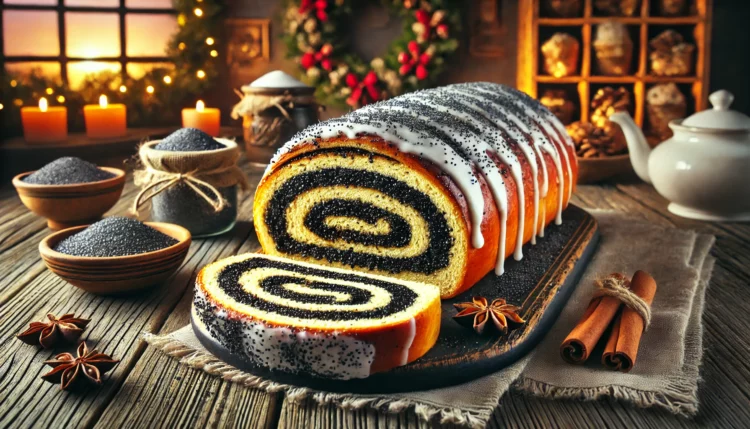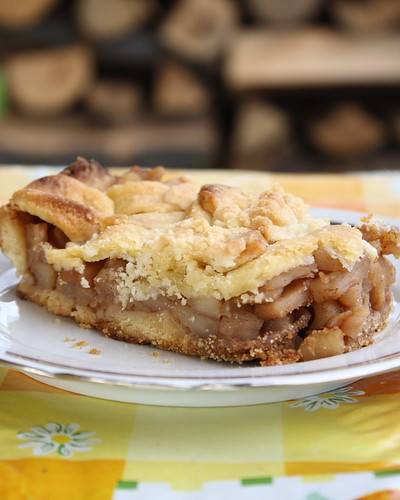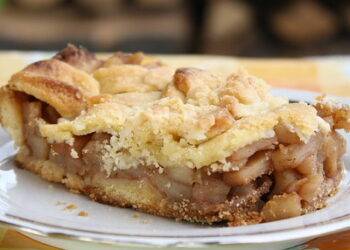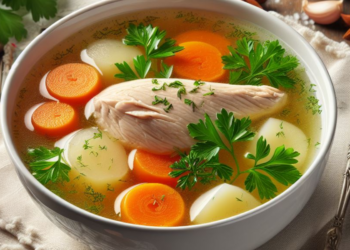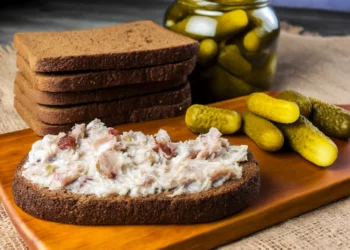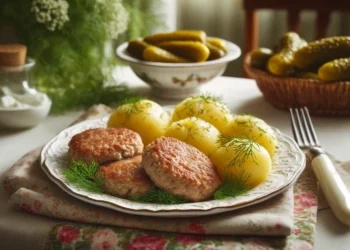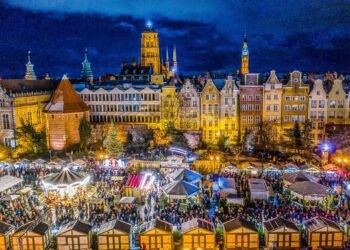Few desserts are as beloved in Poland as makowiec, the traditional poppy seed roll that graces Polish tables during holidays, special occasions, and family gatherings. With its rich filling of ground poppy seeds, sugar, honey, and sometimes dried fruit or nuts, wrapped in soft, sweet yeast dough, makowiec is more than just a pastry—it’s a symbol of home, tradition, and celebration. For many Poles, the sight and smell of makowiec evokes cherished memories of childhood, family kitchens, and festive feasts.
In this article we’ll explore the history, cultural significance, and symbolism of this iconic Polish dessert. Though its ingredients and preparation may vary slightly from region to region, makowiec remains a cherished treat that represents much more than its delicious flavor. You’ll find the recipe right at the bottom of the article.
A Brief History of Makowiec
Makowiec has roots that stretch back centuries, with influences from various Central and Eastern European culinary traditions. The use of poppy seeds in cooking and baking is deeply embedded in the food culture of countries like Poland, Hungary, Czechia, and Austria. However, Poland is often considered the home of makowiec, where this dessert has become synonymous with Christmas and other important celebrations.
Historically, poppy seeds were considered a symbol of prosperity, fertility, and good fortune. In Polish culture, they were believed to bring blessings and abundance, making them a common ingredient in celebratory dishes. This symbolism is one reason why makowiec is a must-have at the Christmas table. The poppy seed filling, with its distinctive nutty and slightly sweet flavor, was seen as a way to ensure a prosperous and successful year ahead. It wasn’t uncommon for Polish families to prepare several loaves of makowiec to share with friends and family during the holidays, often gifting them as tokens of goodwill.
Over time, makowiec became a staple in Polish households, not just during Christmas but also during other significant occasions like Easter, weddings, and family gatherings. Though the dessert has evolved slightly over the centuries, the essence of makowiec—its connection to tradition, family, and celebration—has remained the same.
Cultural Significance and Symbolism
Makowiec’s connection to Polish culture runs deep, especially during the Christmas season. In fact, makowiec is often referred to as one of the “twelve dishes” traditionally served on Wigilia, the Christmas Eve supper that is central to Polish holiday celebrations. Wigilia, which translates to “vigil,” is a meatless feast that includes twelve different dishes, symbolizing the twelve apostles. Each dish has its own significance, and makowiec represents abundance and blessings for the coming year.
The importance of poppy seeds in Polish culture is not limited to Christmas alone. Poppy seeds have long been associated with fertility and good fortune, and they appear in various Polish customs and superstitions. In some traditions, poppy seeds were scattered in the fields to ensure a bountiful harvest, while in others, they were used in wedding cakes or other celebratory treats to bring good luck to newlyweds.
Makowiec’s use of poppy seeds is also linked to the idea of peaceful rest and sleep, as the poppy flower is often associated with sleep and dreams in many cultures. In a metaphorical sense, enjoying makowiec during holidays brings comfort, warmth, and a sense of well-being—a much-needed respite after a busy year.
Variations of Makowiec
While the classic makowiec is a rolled pastry filled with a rich poppy seed filling, there are several variations of the dessert that highlight regional preferences and family traditions. For example, some versions of makowiec are enhanced with dried fruits like raisins or apricots, while others include a mix of chopped nuts like walnuts or almonds for added texture and flavor. Some bakers also flavor the poppy seed filling with a hint of orange zest, lemon, or vanilla, creating a unique twist on the traditional recipe.
In some parts of Poland, you might find makowiec z lukrem, a poppy seed roll glazed with a sweet icing or powdered sugar, which gives the pastry a delicate sweetness and enhances its visual appeal. Alternatively, some variations include a thin layer of marzipan or almond paste rolled into the dough, adding an extra element of richness.
While these variations can add different textures and flavors to the dessert, the core of makowiec—the fragrant, earthy sweetness of the poppy seed filling—remains the star of the show.
Makowiec at Celebrations and Family Gatherings
Makowiec isn’t just a holiday treat; it’s also a staple at other important family celebrations throughout the year. Weddings, baptisms, name days, and other family gatherings often feature makowiec as part of the dessert spread, alongside other traditional Polish cakes like sernik (cheesecake) and szarlotka (apple pie). The act of serving makowiec to guests reflects the Polish custom of hospitality, where sharing food is seen as a way of expressing love, generosity, and warmth.
Makowiec is also a dessert that brings families together in the kitchen. Preparing makowiec is often a multi-generational affair, with grandmothers, mothers, and children working together to prepare the dough, grind the poppy seeds, and roll the perfect loaf. The process can be time-consuming, but it’s also a cherished tradition that reinforces the bonds of family and preserves culinary heritage.
You may also be interested in
Polish Cookbook Wins Prestigious Award in the U.S.
In a remarkable achievement, Michał Korkosz’s cookbook “Polish’d vel Nowe Rozkoszne” has won the Foreword Indies award for Best Cookbook…
Delight Your Taste Buds with Traditional Polish Szarlotka – Recipe
Discover the authentic recipe for Polish Szarlotka, a delightful apple pie that combines a buttery crust with a sweet, cinnamon-spiced…
In addition to its role in family celebrations, makowiec has found its way into Polish bakeries and cafes, where it’s enjoyed year-round as a snack or dessert. Whether enjoyed with a cup of tea or coffee or served as part of a grand holiday meal, makowiec continues to delight with its timeless combination of flavors and textures.
Makowiec’s International Reach
While makowiec is a distinctly Polish treat, its popularity extends beyond Poland’s borders. Polish immigrants brought the tradition of makowiec with them to countries like the United States, Canada, and the United Kingdom, where it remains a cherished connection to their homeland. In areas with large Polish communities, such as Chicago or Greenpoint, Brooklyn, you’ll find bakeries that specialize in traditional Polish pastries, including makowiec.
The influence of makowiec can also be seen in other Central and Eastern European cuisines. Variations of the poppy seed roll can be found in Hungary (bejgli), Czechia (makovník), Slovakia, and Austria, each with its own local twist but sharing the same core ingredients and cultural significance.
Conclusion: A Sweet Tradition That Endures
Makowiec is more than just a dessert; it’s a slice of Polish tradition, representing warmth, family, and the joys of home. Its rich history and cultural significance make it a cornerstone of Polish celebrations, especially during Christmas, but it’s also a beloved treat for many other occasions. With its delicate dough and fragrant poppy seed filling, makowiec continues to captivate taste buds and evoke fond memories across generations.
Whether you grew up enjoying makowiec at holiday feasts or are discovering it for the first time, one thing is certain: this sweet, traditional pastry holds a special place in the heart of Polish cuisine, and it’s a delightful way to connect with the rich culinary heritage of Poland.
So, the next time you enjoy a slice of makowiec, take a moment to savor not only the delicious flavors but also the history, symbolism, and traditions behind this beloved Polish classic. Smacznego! (Enjoy your meal!)
Traditional Polish Makowiec Recipe (Poppy Seed Roll)
Ingredients (Serves 8-10):
For the Dough:
- 2 cups (250g) all-purpose flour
- 2 1/4 teaspoons (7g) active dry yeast (or one packet)
- 1/3 cup (75g) sugar
- 1/2 cup (120ml) warm milk (about 100°F/38°C, warm but not hot)
- 2 egg yolks
- 4 tablespoons butter, melted
- 1 teaspoon vanilla extract
- Pinch of salt
For the Poppy Seed Filling:
- 1 1/2 cups (200g) ground poppy seeds (you can buy them pre-ground or grind them yourself)
- 1/2 cup (100g) sugar
- 1/2 cup (120ml) milk
- 2 tablespoons butter
- 1/4 cup (50g) honey
- 1/4 cup raisins (optional)
- 1/4 cup chopped nuts (walnuts or almonds, optional)
- 1 egg white, beaten (for brushing the dough)
For Glaze (Optional):
- 1/2 cup powdered sugar
- 1-2 tablespoons lemon juice or water (for a simple glaze)
Instructions:
Step 1: Activate the Yeast
- In a small bowl, mix the warm milk (make sure it’s not too hot or it will kill the yeast), sugar, and yeast. Stir lightly and let it sit for about 5-10 minutes until it becomes frothy and bubbly. This means the yeast is activated!
Step 2: Prepare the Dough
- In a large mixing bowl, combine the flour and a pinch of salt. Make a well in the center.
- Add the frothy yeast mixture, egg yolks, melted butter, and vanilla extract to the flour.
- Mix everything together until it starts to form a dough. You can use a spoon or your hands to mix.
- Knead the dough on a lightly floured surface for about 5-7 minutes, until it becomes smooth and elastic. If it’s too sticky, sprinkle a little more flour, but don’t add too much or the dough will become tough.
Step 3: Let the Dough Rise
- Place the dough in a lightly greased bowl and cover it with a clean kitchen towel.
- Let it rise in a warm place for about 1 to 1.5 hours, or until it doubles in size.
Step 4: Prepare the Poppy Seed Filling
- In a saucepan over medium heat, combine the ground poppy seeds, milk, sugar, butter, and honey.
- Stir constantly for about 5-7 minutes, until the mixture thickens slightly. You’ll know it’s ready when the liquid is mostly absorbed, and the mixture looks creamy and moist, but not watery.
- Remove from heat and let it cool.
- If using, stir in the raisins and nuts once the filling has cooled slightly.
Step 5: Roll Out the Dough
- Once the dough has doubled in size, punch it down to release the air.
- Roll the dough out on a floured surface into a rectangle, about 1/4 inch thick (about the size of 12×14 inches or 30×35 cm).
Step 6: Spread the Poppy Seed Filling
- Spread the cooled poppy seed filling evenly over the dough, leaving about a 1-inch border around the edges.
- Starting from one of the longer sides, carefully roll the dough into a tight log, like a jelly roll.
- Pinch the seams and tuck in the ends to seal the roll.
Step 7: Prepare for Baking
- Place the rolled dough seam-side down on a baking sheet lined with parchment paper.
- Cover it with a kitchen towel and let it rise for another 30 minutes.
- Preheat your oven to 350°F (175°C).
Step 8: Brush and Bake
- Brush the roll with the beaten egg white to give it a shiny golden crust.
- Bake in the preheated oven for 30-35 minutes, until the roll is golden brown on the outside.
Step 9: Optional Glaze
- If you want to add a glaze, mix the powdered sugar with lemon juice or water until smooth.
- Once the Makowiec has cooled slightly, drizzle the glaze over the top.
Tips for a Homemade Taste:
- Patience is key! Letting the dough rise properly gives it that soft, homemade texture.
- Don’t rush the filling: The poppy seed mixture needs time to cook and absorb the milk for the best texture. Make sure it’s thick enough to spread but not runny.
- Ground poppy seeds: If you can’t find ground poppy seeds, you can grind whole seeds in a coffee grinder or buy them pre-ground from specialty stores.
Total Time:
- Preparation time: 30 minutes (active)
- Rising time: 1.5 to 2 hours
- Cooking time: 30-35 minutes
- Total time: Around 2.5 to 3 hours
Servings: 8-10 slices of delicious Makowiec
Consider supporting Poland 24
Poland 24 is an independent publication dedicated to providing accurate, insightful, and timely news from Poland. In an era where reliable journalism is more important than ever, we take pride in delivering content that keeps you informed about the latest developments in politics, culture, and society in Poland. However, as an independent outlet, we rely on the support of our readers to continue operating without the influence of corporate sponsors or political agendas. Your donations are crucial to help us maintain the quality of our reporting, covering both major headlines and the stories that often go untold by mainstream media.
By supporting Poland 24, you are not only helping us sustain our website, but you are also contributing to the creation of more diverse, in-depth content. Every donation, big or small, allows us to invest in better resources, hire experienced journalists, and cover a wider range of topics with the detail and attention they deserve. If you value independent journalism and want to see more high-quality content about Poland, please consider donating today. Your support truly makes a difference in our ability to continue bringing important news to the public.

